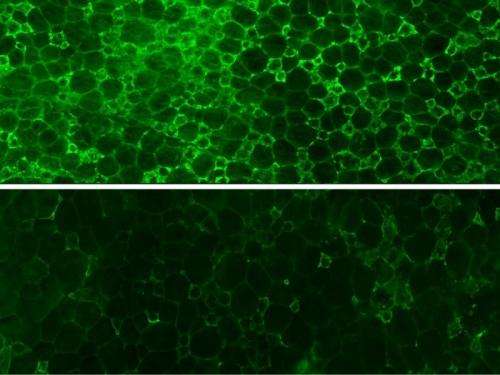Explaining 'healthy' obesity

Up to one-quarter of individuals currently labeled as obese are actually metabolically healthy and do not have a high risk of developing type 2 diabetes. Though obesity is a major risk factor for diabetes, the two conditions aren't always linked. A study published by Cell Press July 3rd in the journal Cell sheds light on a possible explanation, revealing that high levels of a molecule called heme oxygenase-1 (HO-1) are linked to poor metabolic health and an increased risk of type 2 diabetes in obese humans. Moreover, HO-1 inhibition improves metabolic health in obese mice, suggesting that HO-1 blockers could represent a promising new strategy for the treatment of metabolic disease.
"The results indicate that HO-1 is in fact necessary for the development of metabolic disease and call for a re-evaluation of numerous findings in the field," says senior study author Harald Esterbauer of the Medical University of Vienna. "The study also reveals HO-1 as a candidate biomarker for the stratification of metabolically healthy and unhealthy obesity and provides a framework for selective, personalized therapy."
The factors that determine whether obesity leads to poor metabolic health have been unclear, but the evidence suggests that a maladaptive immune response called metabolic inflammation plays an important role. However, studies examining the relationship between a supposedly anti-inflammatory molecule called HO-1 and metabolic disease have produced conflicting results.
To address this question, Esterbauer teamed up with senior study author J. Andrew Pospisilik of the Max Planck Institute of Immunobiology and Epigenetics. In contrast to past findings, they found higher levels of HO-1 in liver and fat biopsies from obese, insulin-resistant humans compared with obese, metabolically healthy individuals. When the researchers deleted the HO-1 gene in immune cells called macrophages, molecular signs of inflammation decreased in mice, suggesting that HO-1 actually promotes inflammation, contrary to widespread belief. Moreover, deletion of the HO-1 gene specifically in the liver or macrophages of mice fed a high-fat diet led to better liver function and an increase in insulin sensitivity—a clear sign of improved metabolic health.
"Our findings show that HO-1 is among the strongest predictors of metabolically unhealthy obesity in humans, and it could have a high prognostic value for detecting disease onset," Pospisilik says. "This could allow clinicians to use targeted interventions to prevent disease progression specifically in obese individuals who show early signs of type 2 diabetes."
More information: Cell, Jais et al.: "Heme Oxygenase-1 Drives Metaflammation and Insulin Resistance in Mouse and Man." www.cell.com/cell/abstract/S0092-8674(14)00671-0















